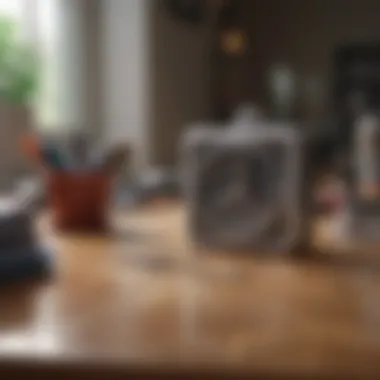Efficient Home Cleaning Organization Strategies


Intro
In the realm of home management, the significance of an organized cleaning approach cannot be overstated. With increasingly busy lifestyles, maintaining a tidy and welcoming living space can feel daunting. A methodical organization of cleaning tasks not only enhances efficiency but also brings a sense of satisfaction.
This article delves deep into the structural aspects of cleaning organization. It addresses the importance of mapping out specific cleaning routines tailored to your home’s unique needs. By adopting a systematic framework, individuals can prioritize their efforts and streamline their routines. We will explore practical strategies that can transform chaotic cleaning habits into structured and manageable tasks.
Exquisite Architectural Designs
While the primary focus remains on cleaning, understanding the architectural layout of your home can influence how one approaches organization and cleaning efforts. Recognizing unique features or areas that require more attention is essential in creating an effective cleaning strategy.
Unique Home Features
Every home has distinctive characteristics which influence its upkeep. These can include:
- High ceilings that gather dust
- Architectural nooks that trap dirt
- Open-plan layouts requiring different cleaning techniques
Appropriately categorizing these features guides effective cleaning schedules. For example, homes with large windows should implement a regular window cleaning routine. This ensures that all unique aspects are maintained properly, consequently enhancing the overall aesthetic appeal of the space.
Historical Significance
Many homes possess historical value, which may necessitate special cleaning techniques. For instance, older homes might feature delicate moldings or antique furnishings. These elements might need gentle care, avoiding harsh chemicals. Understanding the historical significance not only preserves the home's integrity, but also serves as a guide for tasks and products to use in cleaning.
Interior Decorating Tips
Proper organization of cleaning tasks is complemented by an understanding of interior design principles. Well-decorated spaces can either streamline cleaning or complicate it based on how the decor interacts with maintenance routines.
Color Schemes and Trends
Color choices impact not only the aesthetic but also the cleaning requirements. Lighter colors may show stains or dust more easily, prompting a more frequent cleaning schedule. Darker tones tend to hide imperfections, potentially leading to less frequent cleaning.
Some trending color combinations influence how people maintain their homes. Popular palettes invite diverse cleaning products and methods, aligning with current design preferences.
Space Optimization Techniques
An optimized living space can greatly improve cleaning efficiency. Here are a few methods to optimize space:
- Utilize storage solutions to minimize clutter.
- Implement multifunctional furniture.
- Create zones that separate high-traffic areas from less frequently used spaces.
These techniques not only enhance the visual appeal but enable more straightforward cleaning routines, allowing for quicker access to cleaning tools and products.
"A clean home is a reflection of a well-organized mind. By structuring cleaning tasks systematically, we enhance both our environment and our mental clarity."
By following these guidelines and understanding your home’s unique features and design principles, you can enrich your cleaning strategy. This methodical approach lays the groundwork for a cleaner, more harmonious living environment, tailored to the specific characteristics of your home.
Understanding the Need for Organization
In the realm of home management, organization plays a pivotal role that transcends mere aesthetics. It shapes the quality of life by establishing a framework that can significantly enhance efficiency and reduce stress. An organized home fosters a sense of control, which is vital in today’s fast-paced environments. When every item has its designated space and every task has its structure, one can navigate daily life with increased clarity.
The clarity that arises from a well-organized space cannot be overstated. It minimizes distractions, providing an environment conducive for focused activities, whether it is work from home or family time. Additionally, a systematic approach to cleaning helps individuals identify their cleaning needs more accurately, allowing for better resource allocation.
Often, potential cleaning disasters emerge from an unorganized space. The longer one postpones maintaining order, the larger the mess becomes. The implications go beyond chaos; it often leads to feelings of overwhelm and frustration. Organizing effectively can, therefore, be viewed as a preemptive strategy to avert such situations.
The Psychological Benefits of an Organized Space
Maintaining organization offers distinct psychological advantages. Firstly, a clean home is linked to numerous mental health benefits. Studies suggest that organization leads to reduced levels of anxiety and increased productivity. When surroundings are cluttered and chaotic, the mind mirrors these feelings, leading to heightened stress and lack of focus.
Moreover, the state of one’s living space can impact one’s mood. An organized home translates to a sense of achievement. The act of organizing can be therapeutic, leading to improved mental health and self-esteem. In a clutter-free zone, individuals may find that they are more relaxed and able to think clearly.
Common Cleaning Challenges
Despite the benefits of an organized space, various challenges can impede effective cleaning. Common obstacles include lack of time, motivation, and resources. Many are also faced with the overwhelming task of figuring out where to start when the cleaning backlog feels insurmountable.
Another frequent issue arises from confusing cleaning products and tools. Without knowing which products are suitable for specific surfaces, one may end up making cleaning less effective or even damaging belongings. Additionally, organizing and cleaning involve physical labor that can be daunting.
"The first step in solving a problem is recognizing there is one."
This sentiment echoes well when confronting cleaning challenges. Recognizing the barriers involved in cleaning is crucial to formulating a practical plan. Once these obstacles are understood, systematic methods can be employed to address them, thereby facilitating a more manageable and successful cleaning routine.
Setting Clear Objectives for Cleaning
Setting clear objectives for cleaning is a critical step in creating a successful and efficient cleaning routine. When you have specific goals in mind, it becomes easier to develop a plan, allocate time, and measure results. Defining your cleaning objectives allows you to approach the task methodically rather than haphazardly, leading to a more organized and effective cleaning process.


By establishing clear goals, you can target specific areas in your home that need attention. This might include focusing on frequently used spaces like kitchens and bathrooms, or addressing neglected areas such as attics or basements. A well-defined objective gives direction and helps to avoid the overwhelming feeling that often accompanies large cleaning tasks. Instead of viewing cleaning as a massive undertaking, it becomes a series of manageable tasks that can be completed step by step.
Additionally, setting objectives fosters motivation. When you can visualize the end goal—whether that is a sparkling kitchen or a clutter-free living room—it becomes easier to commit to the cleaning process. Moreover, clear objectives enable you to recognize progress, which offers positive reinforcement.
Determining Your Cleaning Goals
Determining your cleaning goals involves assessing the current state of your home and identifying what you want to achieve. Start by evaluating different areas:
- Living Rooms: Do you want to create a more inviting atmosphere?
- Bedrooms: Is the aim a peaceful sleeping environment?
- Kitchens: Are you seeking efficiency in meal preparation and cleanliness?
Once these questions are answered, list your goals. Your list may include items like:
- Decluttering each room.
- Deep cleaning carpets and upholstery.
- Organizing storage areas.
Having specific goals keeps your cleaning organized and purposeful. Each objective should be achievable and time-bound, which will guide you through your cleaning journey with clarity.
How to Prioritize Tasks
Prioritizing tasks is essential for effective cleaning. Not every area requires the same level of attention at the same time. To prioritize tasks, consider the following steps:
- Assess the Areas of Use: Focus on high-traffic areas that require frequent cleaning.
- Determine the Impact of Each Task: Some cleaning tasks will have a larger impact on the overall ambiance and functionality of your home.
- Create a Timeline: Allocate time to each task based on its priority and your availability.
- Use a Checklist: Building a checklist can help track completed tasks and visualize progress.
For example, if the kitchen is the heart of your home, start by ensuring it is clean and organized before moving to less frequently used spaces like guest rooms.
Setting priorities prevents you from feeling overwhelmed and allows you to maintain focus on one task at a time, which is essential for efficiency.
Keeping these considerations in mind, you can develop a methodical approach that aligns with your cleaning objectives and leads to a well-organized home.
Creating a Comprehensive Cleaning Checklist
Creating a comprehensive cleaning checklist is a critical step in the home cleaning organization process. It serves as a roadmap for tackling cleaning tasks in an orderly and efficient manner. With a well-organized checklist, individuals can visualize their objectives and monitor their progress, making the cleaning experience less daunting and more manageable. The benefits of utilizing a checklist are multiple; it not only saves time but also enhances motivation by providing a clear structure that one can follow.
Furthermore, a checklist helps in avoiding oversight of important tasks that can often be forgotten in the hustle of daily life. It encourages completeness in cleaning efforts, ensuring that no corner is overlooked. When each item on the checklist is checked off, it results in a sense of achievement and can significantly reduce stress related to house maintenance.
Categorizing by Room
Categorizing by room is an effective strategy that streamlines the cleaning process. By breaking down tasks according to different areas of the home, you can focus and accomplish specific objectives without feeling overwhelmed. For instance, a checklist for the living room may include tasks such as dusting shelves, vacuuming the floor, and cleaning windows. In contrast, a kitchen checklist can focus on wiping counters, cleaning appliances, and mopping the floor.
This method allows you to allocate your time and energy more efficiently. When you concentrate on one room at a time, it minimizes the risk of getting sidetracked. You can see your progress in a tangible way, as each completed room adds to an overall feeling of accomplishment.
Incorporating Seasonal Tasks
Incorporating seasonal tasks into your checklist is essential for maintaining a clean home year-round. Some cleaning tasks are not needed on a regular basis but are critical to ensuring every part of the home remains in good shape. For instance, tasks such as deep cleaning carpets, washing windows, or organizing the garage typically occur at specific times of the year.
By scheduling and including these seasonal tasks on your checklist, you prepare yourself ahead of time and reduce the chances of letting important duties slip through the cracks. You can create a separate section on your checklist for seasonal tasks, categorizing them by the time they need to be performed. This strategy ensures that a thorough cleaning routine extends beyond the regular weekly or monthly upkeep.
"An effective cleaning checklist not only provides direction but also instills a sense of order and accomplishment, making the process of cleaning less overwhelming and more enjoyable."
In summary, a comprehensive cleaning checklist crafted with consideration of room-specific tasks and seasonal obligations is a powerful tool for anyone seeking to enhance their home organization. This mindful approach to cleaning results not only in a tidier home but also in a more organized mind.
Developing an Efficient Cleaning Schedule
Creating a cleaning schedule is a fundamental aspect of home organization. An effective schedule helps to ensure consistency in maintaining cleanliness, thus reducing the buildup of dirt and clutter. By establishing a structured routine, homeowners can break tasks into manageable segments, making the overall process less overwhelming. It offers clear guidelines for what to do and when, promoting efficiency and saving time in the long run.
Moreover, a well-planned cleaning schedule allows for the thoughtful distribution of cleaning tasks throughout the week or month. This can cater to various lifestyles and preferences, ensuring that no aspect of home maintenance is neglected. Individual routines can accommodate familial obligations, work commitments, or personal leisure time, thereby making cleaning more adaptable to life’s fluxes.
Daily, Weekly, and Monthly Routines
A cleaning schedule can be segmented into daily, weekly, and monthly activities. Daily routines focus on tasks that keep basic cleanliness in check. Simple activities, like making beds, wiping countertops, and doing dishes, should be performed regularly. This immediate upkeep prevents clutter from accumulating and makes weekly deep cleaning less daunting.
Weekly tasks can include vacuuming, mopping floors, and cleaning bathrooms. These activities address areas that require more attention but are still manageable within a week. Assigning specific days for these chores aids in systematic cleaning. For instance, one might designate Mondays for bathroom cleaning and Thursdays for vacuuming.
Monthly cleaning tasks, however, might involve more thorough actions like dusting blinds, washing windows, or organizing closets. Allocating time at the end of each month to examine these areas ensures they do not fall into disarray over time.
"An effective schedule allows for thoughtful distribution of cleaning tasks throughout the week or month."
In conjunction with this, homeowners may create detailed checklists dedicated to each segment of the schedule, refining tasks further into actionable steps. This level of detail can significantly enhance a cleaning routine by providing clarity and establishing structure.
Adapting Your Schedule to Life Changes
Crafting a cleaning schedule is not a one-size-fits-all approach. Life changes often necessitate adaptations in routines. Significant transitions, such as moving to a new home, welcoming a new family member, or changing jobs, can disrupt established patterns. A flexible cleaning schedule accommodates these shifts, ensuring that the cleaning routine remains relevant.


When experiencing changes in daily life, it’s beneficial to reassess what cleaning tasks can be realistically undertaken. Factors such as decreased available time or modified family obligations may require a realignment of priorities. For example, someone who has recently taken on a job with longer hours might benefit from scheduling lighter, more manageable tasks on weekdays, reserving larger chores for weekends.
Additionally, technology can aid in adapting cleaning schedules. Digital calendars and task management applications allow for quick updates and reminders, helping to maintain accountability. By utilizing these tools, the cleaning preferences can be adjusted to reflect current circumstances, avoiding the pitfalls of stagnation.
In summary, an efficient cleaning schedule integrates the rhythm of daily life with structured organization. By understanding and responding to personal and external changes, homeowners can maintain an orderly and clean living environment that suits their evolving needs.
Gathering Necessary Cleaning Supplies
In the process of organizing a successful cleaning regimen, the collection of necessary cleaning supplies stands as a crucial step. This section emphasizes the significance of having the right tools and products at your disposal, as they can drastically influence both efficiency and outcomes during your cleaning activities. The correct assortment of supplies not only enhances performance but also promotes consistency and ease in executing your cleaning routines.
Essential Cleaning Tools
When it comes to cleaning, having the appropriate tools is paramount. Without them, tasks may take more time and effort, potentially leading to disorganization. Here are some essential cleaning tools that should be part of your kit:
- Vacuum Cleaner: A versatile vacuum is essential for various surfaces, including carpets and hard floors.
- Mop and Bucket: A good-quality mop, combined with a bucket, facilitates effective cleaning of hard surfaces.
- Brushes: Different types of brushes, such as scrub brushes and dusting brushes, are invaluable for focused cleaning efforts.
- Microfiber Cloths: These cloths are effective for dusting, wiping surfaces, and polishing without scratching.
- Broom and Dustpan: A classic tool for quick clean-ups, vital for maintaining cleanliness in high-traffic areas.
- Cleaning Caddy: To keep your supplies organized and easily accessible, a cleaning caddy is beneficial, allowing you to move from room to room with ease.
Having a systematic approach to gathering these tools helps you save time and can encourage more committed cleaning habits.
Eco-Friendly Options to Consider
As awareness of environmental impacts increases, using eco-friendly cleaning products becomes essential for many households. Opting for sustainable cleaning supplies promotes a healthier living space while lessening the negative effects on the planet. Here are some options to consider:
- Vinegar: A natural disinfectant, vinegar can effectively tackle various surfaces and odors.
- Baking Soda: This versatile ingredient works wonders in absorbing odors and can aid in scrubbing tasks without harmful chemicals.
- Castile Soap: A biodegradable soap that is gentle yet effective for many cleaning tasks.
- Essential Oils: Not only do they provide pleasant scents, but oils like tea tree or lavender can also offer antibacterial properties.
- Eco-Friendly Brands: Many companies now offer cleaning products made from natural ingredients. Brands like Seventh Generation or Method focus on sustainability while ensuring effectiveness.
By incorporating these eco-friendly options into your cleaning supplies, you contribute to a healthier environment and foster a space that aligns with your values.
Key Takeaway: Gathering the right cleaning supplies, whether traditional or eco-friendly, is not just about efficiency; it is about creating a space where cleanliness and sustainability coexist.
Executing the Cleaning Plan
Executing a cleaning plan is crucial in ensuring that your home cleaning efforts yield tangible results. A well-organized plan provides a roadmap for your cleaning journey, helping to minimize distractions and maintain focus on tasks at hand. Moreover, systematic execution enhances efficiency. By approaching each area with a clear intention, you can avoid repetitive cleaning and wasted time, ultimately transforming your space more effectively. Furthermore, adhering to your cleaning plan fosters discipline. It establishes a rhythm that can become routine, making cleaning feel less tedious and more manageable.
Techniques for Efficient Cleaning
To optimize your cleaning efforts, consider employing techniques that promote both speed and effectiveness. Here are a few strategies:
- Start with a Clean Slate: Declutter surfaces before beginning the actual cleaning. This prepares your space for a thorough process.
- Top to Bottom Approach: Clean from the top of a room to the bottom. Dust and debris will fall, making it easier to manage and ensuring no area is missed.
- Room-by-Room Strategy: Concentrate on one room at a time. Avoid bouncing around in different spaces to enhance focus and completion.
- Use Cleaning Supplies Wisely: Have all relevant supplies at hand. This minimizes time spent searching for items.
Implementing these techniques can lead to a marked increase in your overall cleaning efficiency. Clarity in method not only streamlines the process but also reduces the likelihood of overlooking key tasks.
Involving Family Members in the Process
Cleaning should not solely be a personal endeavor; involving family members can make the task more enjoyable and less burdensome. Here are some approaches to encourage participation:
- Assign Responsibilities: Designate specific tasks for each person based on their capabilities and interests. For instance, one can handle kitchen cleaning, while another focuses on bathrooms.
- Make it a Team Effort: Collaborate on bigger tasks. Working together can lighten the load and foster a sense of community.
- Establish Cleaning Zones: Divide your home into zones and have everyone take ownership of their space. When individuals feel responsible for their area, they often engage more fully in the cleaning process.
- Create a Reward System: Providing small rewards for completing cleaning tasks can motivate family members to contribute. This could be a special treat or a family movie night.
Engaging your family in home cleaning promotes teamwork and establishes a culture of shared responsibility. This can also instill valuable habits in children, teaching them the importance of maintaining a clean environment.
"Cleaning is not just about removing dirt; it's about creating a space where positivity can thrive."
Emphasizing the importance of collaboration and accountability transforms cleaning into a shared journey, ultimately leading to a more harmonious living environment.
Assessing the Cleaning Outcomes
Assessing the cleaning outcomes is a crucial step in the home cleaning organization process. It allows one to measure the success of cleaning efforts and to determine if the set goals have been achieved. This phase should not be overlooked, because it lays the foundation for continuous improvement. Understanding the effectiveness of the cleaning plan encourages accountability and fosters a sense of accomplishment. Success in cleaning can significantly impact not only the aesthetic of the home but also the well-being of its inhabitants.
Evaluating the Effectiveness of Your Plan
Evaluating your cleaning plan's effectiveness involves a systematic review of what was accomplished versus what was intended. Start by examining the cleaning checklist you created earlier. Did you complete all the tasks you set out to do? Look around your home. Does each room feel cleaner? Is there a noticeable difference in organization?
While evaluating, consider getting feedback from family members or roommates. Involving others provides different perspectives that may uncover areas you missed. This collaborative approach encourages shared responsibility and accountability for maintaining cleanliness. Additionally, documenting successes with photos can provide visual proof of progress.
- Key questions to assess effectiveness:
- Was the cleaning routine followed as planned?
- Did I have all the necessary supplies?
- Were there challenges that hindered my progress?
Taking note of these factors creates a clearer picture of your cleaning journey's effectiveness.
Identifying Areas for Improvement
After evaluating, identifying areas for improvement is the next logical step. No cleaning process is perfect, and every individual has unique obstacles to overcome. Recognizing these hurdles allows for a more tailored approach in future cleaning endeavors.


Take a closer look at the tasks that were either incomplete or took longer than expected. Ask yourself why that happened. Were there tools lacking? Did distractions come into play? Were the expectations set too high?
Consider these strategies to find improvement opportunities:
- Analyze the time spent on each task. Is it realistic based on your schedule?
- Review cleaning tools and supplies used. Are they effective, or do they need upgrading?
- Assess your motivation level. Are you procrastinating, or do you need to adjust your goals?
Maintaining an Organized Cleaning Routine
An organized cleaning routine is essential for achieving an efficient home environment. It is not just about cleaning, but establishing a system that works over time. This approach allows you to maintain the clarity and order achieved through your cleaner strategies. It also reduces the stress associated with clutter and disarray, creating a space that is peaceful and functional.
Adopting Habits for Sustained Clarity
Developing effective habits is crucial in maintaining an organized cleaning routine. Small, consistent actions can make a substantial difference over time. Consider adopting daily rituals, such as a quick tidy-up each morning. This can prevent dirt and clutter from accumulating, freeing up more time for thorough cleaning sessions later.
Another important habit is to designate specific days for cleaning different parts of your home. For example, setting Mondays for the kitchen and Thursdays for bathrooms helps create predictability. This gives you a structured approach and reduces the likelihood of procrastination. It is vital to build a cleaning habit around a schedule that aligns with your lifestyle while avoiding overwhelming tasks.
Creating a checklist can further reinforce these habits. This tool helps you remember tasks and gives a sense of accomplishment when checking off completed items.
Utilizing Technology and Tools for Maintenance
Technology can play an instrumental role in your cleaning routine. There are various applications available today that can aid in organizing cleaning schedules and tracking progress. For example, apps like Todoist or Trello allow you to create lists, set reminders, and customize tasks according to your needs. These tools help in setting clear objectives and ensure routine tasks aren’t overlooked.
Additionally, smart home devices, such as robotic vacuum cleaners, can simplify routine chores. Devices like the iRobot Roomba provide automated cleaning, significantly reducing the time and energy spent on maintaining cleanliness.
Using these technologies appropriately can enhance your organizing efforts. They help maintain standards and provide valuable reminders to keep your routine on track. However, it is also necessary to ensure that technology complements rather than complicates your cleaning efforts.
Establishing an organized cleaning routine is not just a preference; it is a necessity for effective home management.
In summary, maintaining an organized cleaning routine requires consistency and the adoption of effective habits. Utilizing technology further supports your efforts in achieving an orderly home environment. By embedding these practices into your daily life, you can ensure that an organized space remains integral to your lifestyle.
Overcoming Common Cleaning Obstacles
Cleaning can sometimes feel like an insurmountable task, particularly when faced with various obstacles that may hinder progress. Addressing these challenges is critical to establishing an effective cleaning routine. Overcoming common obstacles not only streamlines the cleaning process but also reduces stress levels and fosters a more inviting living environment. This section will delve into two significant challenges faced by many: procrastination and time constraints.
Dealing with Procrastination
Procrastination is perhaps the most pervasive adversary to effective cleaning. It is often a result of feeling overwhelmed by the sheer magnitude of the task at hand. This can lead to a cycle where the longer one delays, the more daunting the prospect of cleaning becomes.
To combat this tendency, you can start by breaking down the cleaning tasks into smaller, manageable chunks. Instead of viewing cleaning as one colossal undertaking, focus on individual rooms or specific areas. Set a timer for 15 minutes and commit to cleaning during that brief period. You may find that once you start, the momentum carries you forward, reducing the urge to procrastinate further.
Consider using checklists to track your progress. This allows you to visually see what has been accomplished, providing a sense of achievement that motivates you to continue. Completing even minor tasks, such as wiping down a kitchen counter or organizing a drawer, can significantly boost your confidence.
Managing Time Constraints
Time constraints are a common barrier that many individuals face when it comes to cleaning. Busy schedules and numerous responsibilities can make it challenging to dedicate sufficient time for cleaning tasks. However, managing this aspect is crucial for maintaining an organized home.
To address time limitations, the implementation of a cleaning schedule becomes beneficial. By allocating specific days for targeted tasks, you can ensure that nothing falls through the cracks. For instance, designating Sundays for laundry and kitchen deep cleaning can help structure your week.
Additionally, prioritizing tasks can help focus your efforts. Identify the areas that require immediate attention, such as high-traffic zones, and tackle those first. This way, you can address urgent cleaning needs effectively without being overwhelmed by the overall duties.
"A little progress each day adds up to big results."
Utilizing cleaning tools and technologies also allows for more efficient house cleaning. Devices such as robotic vacuum cleaners or automated mops can significantly reduce the time required for routine tasks. This enables you to maximize your time investment and achieve a cleaner space without extensive effort.
In summary, overcoming cleaning obstacles like procrastination and time constraints is essential for effective home organization. By breaking down tasks, creating structured schedules, and utilizing available tools, the process becomes more manageable, leading to a lasting impact on the overall cleanliness and organization of your home.
Reflection and Adjustment
Reflection and adjustment are pivotal in maintaining an effective home cleaning organization system. Regularly assessing your cleaning processes can lead to improved efficiency and satisfaction. As life circumstances change, so too should your cleaning routine. For instance, increasing family members or changes in work schedules may require a reevaluation of your previous plans.
The benefits of being reflective are manifold. First, periodic reviews allow you to recognize what works and what doesn’t. This can save both time and effort by focusing resources on successful strategies. Moreover, adjusting approaches promotes adaptability, which is essential in a dynamic living situation. When you are aware that your methods can evolve, you are less likely to feel overwhelmed or stuck.
Additionally, reflection supports long-term organization. It creates a habit of continuous improvement. Consider this: if you only clean based on a static plan, it may lead to burnout or dissatisfaction. By reflecting and adapting consistently, cleaning transforms from a chore into a manageable task. In this way, reflection and adjustment are not merely technical processes; they cultivate a mindset conducive to maintaining your home’s order.
"The strength of your cleaning system lies not in its rigidity but in its adaptability."
Periodic Reviews of Your Cleaning System
Conducting periodic reviews of your cleaning system is essential for ongoing success. These reviews allow you to evaluate the effectiveness of your current strategies. Imagine setting aside time every few months to assess your routines. You can ask essential questions like: Are the cleaning tasks still relevant? Are some areas neglected?
During these reviews, make a note of cleaning tasks that are routinely skipped or poorly executed. These are opportunities for rethinking your system. If certain rooms take more time than anticipated, consider whether you need additional resources or techniques.
A useful approach is to maintain a checklist. This can serve as a reference for both completed tasks and outstanding work needing attention. Incorporating feedback from family members can also be beneficial. They may notice areas that require attention or suggest different cleaning methods.
Adjusting Goals and Techniques as Necessary
Adjusting goals and techniques as necessary ensures your cleaning organization remains relevant and effective. Goals should not be set in stone. As your needs evolve, your cleaning objectives may too. For example, you might aim for a deeper clean during certain seasons or focus on decluttering during life transitions.
Techniques used should also be revisited. New cleaning products or tools may enter the market that could enhance your efficiency. Be open to exploring these alternatives as they may simplify tasks.
Another consideration is to reflect on your work’s value. Do your cleaning methods promote a sense of pride in your space? If you find that they don’t, it may be time to reassess. Setting aside moments to analyze your work process and outcomes can lead to invaluable insights.















